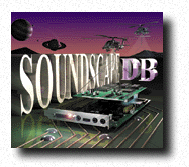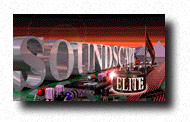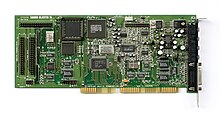
A sound card is an internal expansion card that provides input and output of audio signals to and from a computer under the control of computer programs. The term sound card is also applied to external audio interfaces used for professional audio applications.

Sound Blaster is a family of sound cards and audio peripherals designed by Creative Technology/Creative Labs of Singapore. The first Sound Blaster card was introduced in 1989.

Digital waveguide synthesis is the synthesis of audio using a digital waveguide. Digital waveguides are efficient computational models for physical media through which acoustic waves propagate. For this reason, digital waveguides constitute a major part of most modern physical modeling synthesizers.

A digital audio workstation is an electronic device or application software used for recording, editing and producing audio files. DAWs come in a wide variety of configurations from a single software program on a laptop, to an integrated stand-alone unit, all the way to a highly complex configuration of numerous components controlled by a central computer. Regardless of configuration, modern DAWs have a central interface that allows the user to alter and mix multiple recordings and tracks into a final produced piece.
The Environmental Audio Extensions are a number of digital signal processing presets for audio, present in Creative Technology Sound Blaster sound cards starting with the Sound Blaster Live and the Creative NOMAD/Creative ZEN product lines. Due to the release of Windows Vista in 2007, which deprecated the DirectSound3D API that EAX was based on, Creative discouraged EAX implementation in favour of its OpenAL-based EFX equivalent – though at that point relatively few games used the API.

The Gravis UltraSound or GUS is a sound card for the IBM PC compatible system platform, made by Canada-based Advanced Gravis Computer Technology Ltd. It was very popular in the demoscene during the 1990s.

There have been various families of Yamaha audio controllers labelled as YMF7xx.

Soundscape S-2000 was Ensoniq's first direct foray into the PC sound card market. The card arrived on the market in 1994. It is a full-length ISA digital audio and sample-based synthesis device, equipped with a 2 MiB Ensoniq-built ROM-based patch set. Some OEM versions of the card feature a smaller 1 MiB patch set. It was praised for its then-high quality music synthesis and sound output, high compatibility and good software support.

The SoundscapeDB is an Ensoniq-designed and produced MIDI daughtercard designed to interface with the "Waveblaster" pin header available on many older sound cards. It was released in 1994.

The Soundscape Elite was Ensoniq's high-end ISA PC sound card offering. It offers the highest MIDI quality of any PC sound card Ensoniq produced. The board is an evolution of the company's previous Soundscape S-2000. The Soundscape ELITE was launched in March 1995.

The Ensoniq AudioPCI is a Peripheral Component Interconnect (PCI)-based sound card released in 1997. It was Ensoniq's last sound card product before they were acquired by Creative Technology. The card represented a shift in Ensoniq's market positioning. Whereas the Soundscape line had been made up primarily of low-volume high-end products full of features, the AudioPCI was designed to be a very simple, low-cost product to appeal to system OEMs and thus hopefully sell in mass quantities.

Sound Blaster Live! is a PCI add-on sound card from Creative Technology Limited for PCs. Moving from ISA to PCI allowed the card to dispense with onboard memory, storing digital samples in the computer's main memory and then accessing them in real time over the bus. This allowed for a much wider selection of, and longer playing, samples. It also included higher quality sound output at all levels, quadrophonic output, and a new MIDI synthesizer with 64 sampled voices. The Live! was introduced on August 11, 1998 and variations on the design remained Creative's primary sound card line into the early 2000's.

Sound Blaster Audigy is a product line of sound cards from Creative Technology. The flagship model of the Audigy family used the EMU10K2 audio DSP, an improved version of the SB-Live's EMU10K1, while the value/SE editions were built with a less-expensive audio controller.

The Sound Blaster AWE32 is an ISA sound card from Creative Technology. It is an expansion board for PCs and is part of the Sound Blaster family of products. The Sound Blaster AWE32, introduced in March 1994, was a near full-length ISA sound card, measuring 14 inches (356 mm) in length, due to the number of features included.

Media Vision Technology, Inc., was an American electronics manufacturer of primarily computer sound cards and CD-ROM kits, operating from 1990 to approximately 1995 in Fremont, California. Media Vision was widely known for its Pro AudioSpectrum PC sound cards—which it often bundled with CD-ROM drives—it is also known for its spectacular growth and demise.

The Media Vision Pro AudioSpectrum family of personal computer sound cards included the original 8-bit Pro AudioSpectrum (1991), the 8-bit Pro AudioSpectrum Plus, 16-bit Pro AudioSpectrum 16, Pro AudioSpectrum 16 Basic and 16-bit Pro Audio Studio. All PAS cards with the exception of Pro AudioSpectrum 16 Basic could connect to CD-ROM drives — variants having SCSI or various proprietary interfaces — and many were sold in multimedia kits with compatible CD-ROM drives.
Moonsound is a sound card released for the MSX home-computer system at the Tilburg Computer Fair in 1995. It was designed by electronic engineer Henrik Gilvad and produced by Sunrise Swiss on a semi-hobby basis.

The Wave Blaster was an add-on MIDI-synthesizer for Creative Sound Blaster 16 and Sound Blaster AWE32 family of PC soundcards. It was a sample-based synthesis General MIDI compliant synthesizer. For General MIDI scores, the Wave Blaster's wavetable-engine produced more realistic instrumental music than the SB16's onboard Yamaha-OPL3.
The OPL series are a family of sound chips developed by Yamaha. The OPL series are low-cost sound chips providing FM synthesis for use in computing, music and video game applications.


















